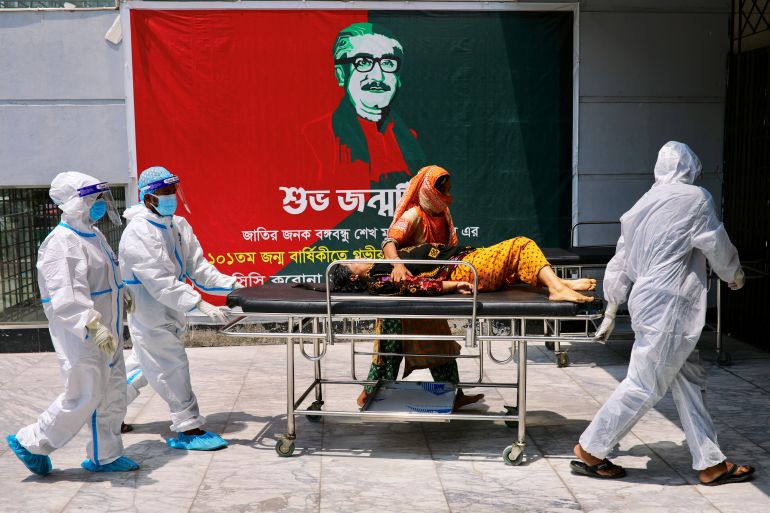Bangladesh hits record COVID cases amid fears of oxygen crisis
The country reports 11,525 cases, the highest in a day since the pandemic started, as authorities fear a shortage of medical oxygen could worsen the crisis.

Bangladesh has reported 11,525 COVID-19 cases, the highest in a day since the start of the pandemic, as authorities fear a crisis of medical oxygen critical in its treatment.
At least 163 people died in the last 24 hours, raising the total number to 15,392, according to the government’s data on Tuesday. The total caseload is 966,406.
Keep reading
list of 4 itemsIn Bangladesh’s empty Armenian church, a lone Hindu worshipper
Diarrhoea kills at least 4 Rohingya on remote Bangladesh island
Clean air group calls out China-backed coal plant in Bangladesh
Bangladesh on Monday extended a strict nationwide lockdown, confining people to their homes for another week as the numbers of coronavirus cases and deaths hit new records.
Bangladesh’s cases of new infections increased last month when the Delta variant – first discovered in India – hit the country’s border regions in the northern and southwestern regions.
The country shares a large border with India, and health experts say the actual numbers of infections and deaths are likely higher.

Meanwhile, oxygen supply at COVID-19 hospitals in Bangladesh is feared to be running out, while hospitals in capital Dhaka are nearing a breaking point amid a record surge in cases.
The country’s health officials say it would be difficult to address the demand for oxygen supply if the daily infections continue to remain high.
The country has a total of 1,217 incentive care unit (ICU) beds, Anadolu Agency reported.
Dhaka alone has 839 ICU beds, which has created huge pressure on the capital and disparity among cities. Of the total, some 356 ICU beds were available as of Tuesday, Anadolu said.
Belal Hossain Rahat, 30, a resident of the southwestern Jhenaidah district, told the agency that both his parents developed breathing difficulties and high fever due to COVID-19 and are currently under treatment at their home.
There is no ICU facility at the Jhenaidah government district hospital, according to the Directorate General of Health Services data.
“The existing poor and faint conditions in the district hospital have forced us to arrange their treatment at home. We have already taken the necessary preparations. And if their condition remains unchanged, we will have to move to Dhaka for better treatment,” Rahat said.

Referring to the current situation in the government hospitals at the districts level, DGHS spokesman Dr Nazmul Islam told Anadolu Agency that the doctor-patient ratio in Bangladesh is only 5.26 per 10,000 people.
“Till now, there is no serious oxygen supply crisis but if the infection figure continues to manifold and people need oxygen then it certainly will be difficult to address the demand,” he said.
“We have already prepared a procurement plan to reserve more oxygen at a number of hospitals.”
The DGHS said it has the capacity to provide 210-220 tonnes of liquid oxygen daily.
But experts and media reports estimate that the daily demand for oxygen has crossed 230 tonnes amid the surging infections since last week.
The country is also facing a crisis in vaccination after India stopped exports of AstraZeneca shots because of its own outbreak in April. Bangladesh has a deal to get 30 million doses from India’s Serum Institute.
Only four million Bangladeshis have been vaccinated in a country of 160 million people. Authorities are hoping to start a new mass vaccination campaign with China’s Sinopharm and other vaccines.